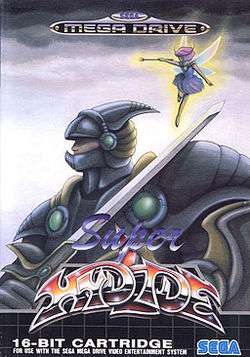Super Hydlide
| Super Hydlide | |
|---|---|
 | |
| Developer(s) | T&E Soft |
| Publisher(s) | Seismic Software |
| Distributor(s) | Sega |
| Series | Hydlide |
| Platform(s) | MSX, MSX2, PC-88, Famicom, Genesis/Mega Drive, X68000 |
| Release date(s) |
MSX
MSX2
PC-88 Famicom
Mega Drive / Genesis X68000
|
| Genre(s) | Action role-playing game |
| Mode(s) | Single player |
Super Hydlide is an action role-playing game for the Sega Genesis/Mega Drive. It was originally released in 1987 in Japan only under the title Hydlide 3: The Space Memories (ハイドライド3 闇からの訪問者 Haidoraido 3: Yami Kara no Hōmonsha) for the MSX, MSX2, and NEC PC-88. Ports were also released for the Nintendo Famicom and the Sharp X68000. The game was developed by Hydlide series veterans T&E Soft and released worldwide on the Sega Genesis / Mega Drive on October 6, 1989, in Japan, early 1990 in the United States, and 1991 in Europe. This remake evidences substantial graphical upgrades to the original Hydlide 3, though the gameplay remains largely identical.[3] Before its release, it was called Hollo Fighter in some Sega advertising material and was one of the first third party published titles to be released in the U.S, the other being Air Diver.
Story
Many years after the events of Hydlide II, an explosion of flames appeared near The City of the Woods. After that, enemies were everywhere. A young man is chosen to find the source of the evil.
Gameplay
The game incorporates a 'good/evil character' morality/alignment system. Like its predecessor Hydlide II: Shine of Darkness (1985), the player has a morality meter that can be aligned with either Justice, Normal, or Evil. The game has both good and evil monsters. Evil monsters attack the player character on sight, while good monsters only attack if the player character attacks them first. Killing any monster, good or evil, results in a reward of experience points, money, and occasionally a piece of equipment. However, if the player kills a good monster, points are lost from a statistic called "MF" (Moral Fiber). If the player's MF stat drops to zero, frequent traps will appear across the world. If the player manages to keep it over 100, rewards appear in the form of random items found around Fairyland. The player can also kill good monsters, which usually lowers the morality meter. Unlike Hydlide II, however, the morality meter no longer affects the way in which the townsfolk react to the player.[3]
The game also features an in-game clock setting day-night cycles, where the character must eat two times a day and sleep regularly. If the characters stay up late or fail to eat regularly, their HP and attack power gradually drop. Every item in the game (including money) has weight. If the total weight of items the player character carries exceeds his "Load Capacity" (LC), he will move slowly. The game uses cut scenes for its opening and ending sequences, a combat system similar to Ys, a choice between four distinct character classes, and a wide variety of equipment and spells.
Reception
Citing the varied experiences offered by the different playable characters, the morality system, and the inclusion of four save slots, GamePro concluded, "Altogether Super Hydlide is a lively cart that draws you into an epic adventure."[4]
Computer and Video Games scored it 81%, stating that, like Phantasy Star II, "this is a huge role-playing game", and that it is "a very tough game" requiring "much brain-work". They criticized the graphics and sound, but said "they do their job, and the gameplay is fairly engrossing". They concluded that "arcade fans will find the lack of action rather dull" but "those who like games with a steady pace and tons of puzzles will love this."[2]
Legacy
In 2007, Alex Lucard of Diehard GameFan listed Super Hydlide at number 27 in his list of top 30 RPGs. He cited the realism instilled by gameplay mechanics such as the encumbrance system, banks, the 24-hour clock, and the need to eat and sleep, and described the game as "Morrowind before there was Morrowind."[5]
During production of Scalebound, Platinum Games director Hideki Kamiya said he was inspired by Hydlide 3 on the PC-8801 MA as well as Sorcerian.[6][7] He said Hydlide 3 was one of the first games he played on a PC and was inspirational because it "had a really hardcore game design that no one was doing on consoles at the time".[8]
Notes
- ↑ http://www.famitsu.com/cominy/?m=pc&a=page_h_title&title_id=28170
- 1 2 https://archive.org/stream/Complete_Guide_to_Sega_The_1990_EMAP_Images_GB#page/n48/mode/1up
- 1 2 Kurt Kalata & Robert Greene, Hydlide, Hardcore Gaming 101
- ↑ "Genesis ProView: Super Hydlide". GamePro. IDG (21): 66–67. June 1990.
- ↑ Lucard, Alex (July 12, 2007). "The Top 30 RPG Countdown". Diehard GameFan. Retrieved 28 June 2015.
- ↑ http://www.polygon.com/a/life-in-japan/Hideki-Kamiya-Scalebound
- ↑ http://www.eurogamer.net/articles/2015-08-07-scalebound-is-a-different-kind-of-platinum-game
- ↑ http://ign.com/articles/2015/08/27/ask-platinumgames-anything-about-scalebound
References
- Englhart, Stephen (August 1992). "Böse überraschung" [Bad Surprise]. Video Games (in German) (8): 91. Retrieved 27 June 2015.
- Hoogh, Eva (November 1990). "Nicht von dieser welt" [Not of this world]. Aktueller Software Markt (in German). Tronic Verlag. 5 (11): 138. Retrieved 27 June 2015.
- Hengst, Michael (November 1990). "Ich Wollt' Ich Wär' Ein Held" [I wish I were a hero]. Power Play (in German): 141.
- Delpierre, Christophe (April 1992). "Il est tout de même étonnant de voir à quel point le monde des jeux vidéos est soumis aux desseins funestes des forces du Mal..." [It remains surprising to see how much the world of video games is subject to the disastrous designs of Evil...]. Player One (in French). Média Système Édition (19): 88. ISSN 1153-4451. Retrieved 27 June 2015.
- Horowitz, Ken (8 December 2005). "Super Hydlide". Sega-16.com. Retrieved 27 June 2015.